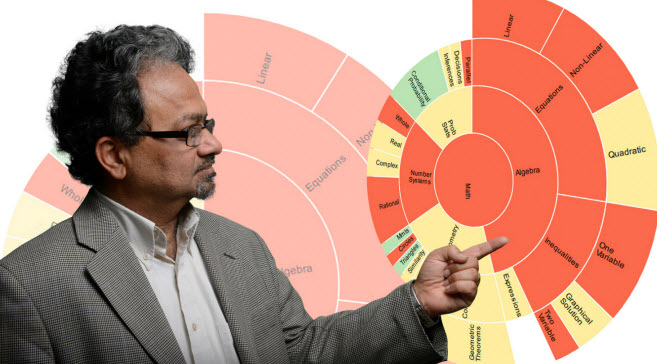IBM revealed its predictions for five big innovations that will change our lives within five years.

Above: Bernie Meyerson, the vice president of innovation at IBM.
The IBM “5 in 5” is the eighth year in a row that IBM has made predictions about technology, and this year’s prognostications are sure to get people talking. We discussed them with Bernie Meyerson, the vice president of innovation at IBM, and he told us that the goal of the predictions is to better marshal the company’s resources in order to make them come true.
“We try to get a sense of where the world is going because that focuses where we put our efforts,” Meyerson said. “The harder part is nailing down what you want to focus on. Unless you stick your neck out and say this is where the world is going, it’s hard to you can turn around and say you will get there first. These are seminal shifts. We want to be there, enabling them.”
(See our complete interview with Meyerson here).
In a nutshell, IBM says:
- The classroom will learn you.
- Buying local will beat online.
- Doctors will use your DNA to keep you well.
- A digital guardian will protect you online.
- The city will help you live in it.
Meyerson said that this year’s ideas are based on the fact that everything will learn. Machines will learn about us, reason, and engage in a much more natural and personalized way. IBM can already figure out your personality by deciphering 200 of your tweets, and its capability to read your wishes will only get better. The innovations are being enabled by cloud computing, big data analytics (the company recently formed its own customer-focused big data analytics lab), and adaptive learning technologies. IBM believes the technologies will be developed with the appropriate safeguards for privacy and security, but each of these predictions raises additional privacy and security issues.
As computers get smarter and more compact, they will be built into more devices that help us do things when we need them done. IBM believes that these breakthroughs in computing will amplify our human abilities. The company came up with the predictions by querying its 220,000 technical people in a bottoms-up fashion and tapping the leadership of its vast research labs in a top-down effort.
Here’s some more detailed description and analysis on the predictions.
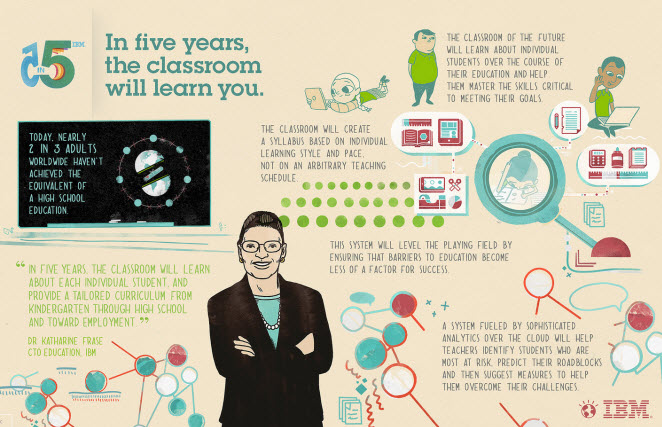
Above: In five years, the classroom will learn you to help tailor instruction to your individual needs.
The classroom will learn you
Globally, two out of three adults haven’t gotten the equivalent of a high school education. But IBM believes the classrooms of the future will give educators the tools to learn about every student, providing them with a tailored curriculum from kindergarten to high school.
“Your teacher spends time getting to know you every year,” Meyerson said. “What if they already knew everything about how you learn?”
In the next five years, IBM believes teachers will use “longitudinal data” such as test scores, attendance, and student behavior on electronic learning platforms — and not just the results of aptitude tests. Sophisticated analytics delivered over the cloud will help teachers make decisions about which students are at risk, their roadblocks, and the way to help them. IBM is working on a research project with the Gwinnett County Public Schools in Georgia, the 14th largest school district in the U.S. with 170,000 students. The goal is to increase the district’s graduation rate. And after a $10 billion investment in analytics, IBM believes it can harness big data to help students out.
“You’ll be able to pick up problems like dyslexia instantly,” Meyerson said. “If a child has extraordinary abilities, they can be recognized. With 30 kids in a class, a teacher cannot do it themselves. This doesn’t replace them. It allows them to be far more effective. Right now, the experience in a big box store doesn’t resemble this, but it will get there.”

Above: In five years, buying local will beat online as you get online data at your fingertips in the store.
Buying local will beat online
Online sales topped $1 trillion worldwide last year, and many physical retailers have gone out of business as they fail to compete on price with the likes of Amazon. But innovations for physical stores will make buying local turn out better. Retailers will use the immediacy of the store and proximity to customers to create experiences that online-only retail can’t replicate. The innovations will bring the power of the Web right to where the shopper can touch it. Retailers could rely on artificial intelligence akin to IBM’s Watson, which played Jeopardy better than many human competitors. The Web can make sales associates smarter, and augmented reality can deliver more information to the store shelves. With these technologies, stores will be able to anticipate what a shopper most wants and needs.
And they won’t have to wait two days for shipping.
“The store will ask if you would like to see a certain camera and have a salesperson meet you in a certain aisle where it is located,” Meyerson said. “The ability to do this painlessly, without the normal hassle of trying to find help, is very powerful.”
This technology will get so good that online retailers are likely to set up retail showrooms to help their own sales.
“It has been physical against online,” Meyerson said. “But in this case, it is combining them. What that enables you to do is that mom-and-pop stores can offer the same services as the big online retailers. The tech they have to serve you is as good as anything in online shopping. It is an interesting evolution but it is coming.”
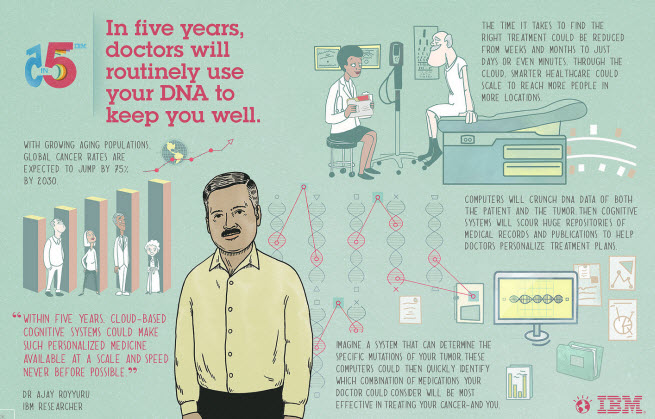
Above: In five years, doctors will routinely use your DNA to keep you well.
Doctors will use your DNA to keep you well
Global cancer rates are expected to jump by 75 percent by 2030. IBM wants computers to help doctors understand how a tumor affects a patient down to their DNA. They could then figure out what medications will best work against the cancer, and fulfill it with a personalized cancer treatment plan. The hope is that genomic insights will reduce the time it takes to find a treatment down from weeks to minutes.
“The ability to correlate a person’s DNA against the results of treatment with a certain protocol could be a huge breakthrough,” Meyerson said. It’ll be able to scan your DNA and find out if any magic bullet treatments exist that will address your particular ailment.
IBM recently made a breakthrough with a nanomedicine that it can engineer to latch on to fungal cells in the body and attack them by piercing their cell membranes. The fungi won’t be able to adapt to these kinds of physical attacks easily. That sort of advance, where the attack is tailored against particular kinds of cells, will be more common in the future.
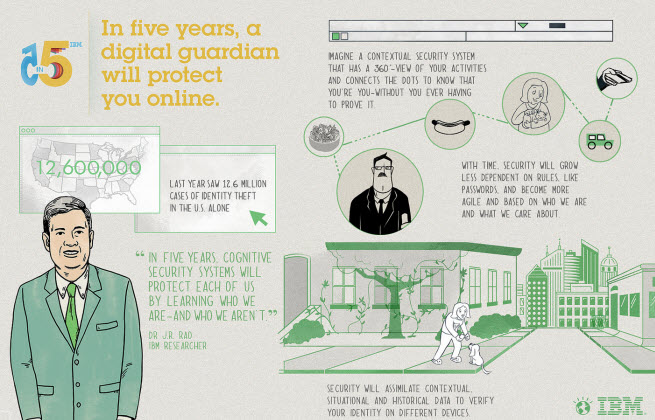
Above: In five years, a digital guardian will protect you online.
A digital guardian will protect you online
We have multiple passwords, identifications, and devices than ever before. But security across them is highly fragmented. In 2012, 12 million people were victims of identity fraud in the U.S. In five years, IBM envisions a digital guardian that will become trained to focus on the people and items it’s entrusted with. This smart guardian will sort through contextual, situational, and historical data to verify a person’s identity on different devices. The guardian can learn about a user and make an inference about behavior that is out of the norm and may be the result of someone stealing that person’s identity. With 360 degrees of data about someone, it will be much harder to steal an identity.
“In this case, you don’t look for the signature of an attack,” Meyerson said. “It looks at your behavior with a device and spots something anomalous. It screams when there is something out of the norm.”
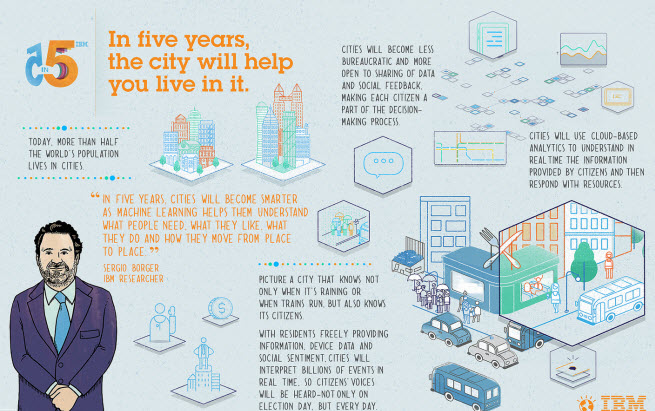
Above: In five years, the city will help you live in it.
The city will help you live in it
IBM says that, by 2030, the towns and cities of the developing world will make up 80 percent of urban humanity and by 2050, seven out of every 10 people will be a city dweller. To deal with that growth, the only way cities can manage is to have automation, where smarter cities can understand in real-time how billions of events occur as computers learn to understand what people need, what they like, what they do, and how they move from place to place.
IBM predicts that cities will digest information freely provided by citizens to place resources where they are needed. Mobile devices and social engagement will help citizens strike up a conversation with their city leaders. Such a concept is already in motion in Brazil, where IBM researchers are working with a crowdsourcing tool that people can use to report accessibility problems, via their mobile phones, to help those with disabilities better navigate urban streets.
Of course, as in the upcoming video game Watch Dogs from Ubisoft, a bad guy could hack into the city and use its monitoring systems in nefarious ways. But Meyerson said, “I’d rather have the city linked. Then I can protect it. You have an agent that looks over the city. If some wise guy wants to make the sewage pumps run backwards, the system will shut that down.”
The advantage of the ultraconnected city is that feedback is instantaneous and the city government can be much more responsive.
